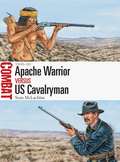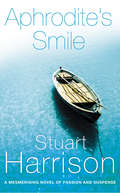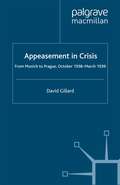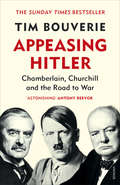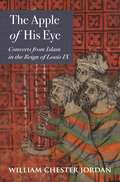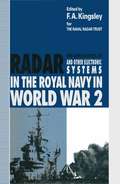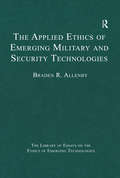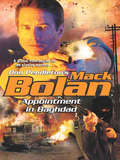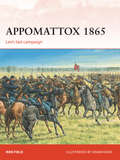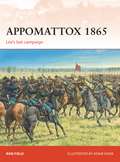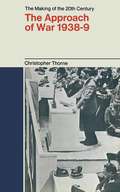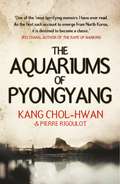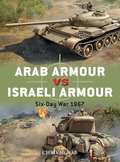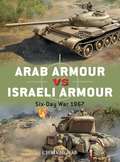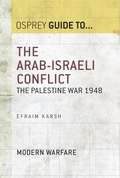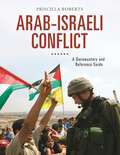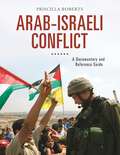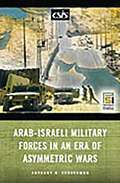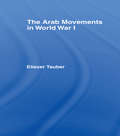- Table View
- List View
Apache Warrior vs US Cavalryman: 1846–86 (Combat)
by Adam Hook Sean McLachlanFrom the 1840s onward, United States military forces clashed with the Apache, a group of Native American peoples associated with the southwestern part of North America. US territorial expansion and conflict – first with Mexico and then during the Civil War – led to an escalation of hostilities that culminated in the defeat of the Apache leader Geronimo in 1886, although fighting continued into the 20th century. In this study the clashes at Cieneguilla (1854), First Adobe Walls (1864), and Cibecue Creek (1881) are assessed in detail.Fully illustrated and featuring contemporary accounts and specially commissioned artwork, this history examines exactly how the Apache were able to pose such a grave threat to US forces and how their initial advantages were gradually negated by the cavalry. Examining the tactics, equipment and training available to each side over four decades of evolving conflict, this is an eye-opening combatant's eye view of one of history's most intriguing campaigns.
Apache Warrior vs US Cavalryman: 1846–86 (Combat)
by Mr Adam Hook Sean McLachlanFrom the 1840s onward, United States military forces clashed with the Apache, a group of Native American peoples associated with the southwestern part of North America. US territorial expansion and conflict – first with Mexico and then during the Civil War – led to an escalation of hostilities that culminated in the defeat of the Apache leader Geronimo in 1886, although fighting continued into the 20th century. In this study the clashes at Cieneguilla (1854), First Adobe Walls (1864), and Cibecue Creek (1881) are assessed in detail.Fully illustrated and featuring contemporary accounts and specially commissioned artwork, this history examines exactly how the Apache were able to pose such a grave threat to US forces and how their initial advantages were gradually negated by the cavalry. Examining the tactics, equipment and training available to each side over four decades of evolving conflict, this is an eye-opening combatant's eye view of one of history's most intriguing campaigns.
Aphrodite’s Smile (Charnwood Large Print Ser.)
by Stuart HarrisonA novel of romantic suspense, set on the beautiful Greek island of Ithaca, from the author of STILL WATER and THE SNOW FALCON.
Appeasement in Crisis: From Munich to Prague, October 1938–March 1939
by D. GillardAfter Munich, the British Government expressed readiness to defend what remained of Czechoslovakia. Six months later, Hitler ignored the warning and faced only verbal condemnation. A fortnight later, Chamberlain's Cabinet tried and failed to protect Poland by a similar 'guarantee'. Their deliberations show how and why they had so miscalculated.
Appeasing Hitler: Chamberlain, Churchill and the Road to War
by Tim Bouverie'Appeasing Hitler is an astonishingly accomplished debut' ANTONY BEEVOR‘One of the most promising young historians to enter our field for years’ MAX HASTINGS‘Brilliant and sparkling … reads like a thriller. I couldn’t put it down’ PETER FRANKOPANOn a wet afternoon in September 1938, Neville Chamberlain stepped off an aeroplane and announced that his visit to Hitler had averted the greatest crisis in recent memory. It was, he later assured the crowd in Downing Street, ‘peace for our time’. Less than a year later, Germany invaded Poland and the Second World War began.Appeasing Hitler is a compelling new narrative history of the disastrous years of indecision, failed diplomacy and parliamentary infighting that enabled Nazi domination of Europe. Beginning with the advent of Hitler in 1933, it sweeps from the early days of the Third Reich to the beaches of Dunkirk. Bouverie takes us into the backrooms of 10 Downing Street and Parliament, where a small group of rebellious MPs, including the indomitable Winston Churchill, were among the few to realise that the only choice was between ‘war now or war later’. And we enter the drawing rooms and dining clubs of fading imperial Britain, where Hitler enjoyed surprising support among the ruling class and even some members of the Royal Family.Drawing on deep archival research, including previously unseen sources, this is an unforgettable portrait of the ministers, aristocrats and amateur diplomats who, through their actions and inaction, shaped their country's policy and determined the fate of Europe. Both sweeping and intimate, Appeasing Hitler is not only eye-opening history but a timeless lesson on the challenges of standing up to aggression and authoritarianism – and the calamity that results from failing to do so.
The Apple of His Eye: Converts from Islam in the Reign of Louis IX (Jews, Christians, And Muslims From The Ancient To The Modern World Ser. #4)
by William Chester JordanThe thirteenth century brought new urgency to Catholic efforts to convert non-Christians, and no Catholic ruler was more dedicated to this undertaking than King Louis IX of France. His military expeditions against Islam are well documented, but there was also a peaceful side to his encounter with the Muslim world, one that has received little attention until now. This splendid book shines new light on the king’s program to induce Muslims—the “apple of his eye”—to voluntarily convert to Christianity and resettle in France. It recovers a forgotten but important episode in the history of the Crusades while providing a rare window into the fraught experiences of the converts themselves.William Chester Jordan transforms our understanding of medieval Christian-Muslim relations by telling the stories of the Muslims who came to France to live as Christians. Under what circumstances did they willingly convert? How successfully did they assimilate into French society? What forms of resistance did they employ? In examining questions like these, Jordan weaves a richly detailed portrait of a dazzling yet violent age whose lessons still resonate today.Until now, scholars have dismissed historical accounts of the king’s peaceful conversion of Muslims as hagiographical and therefore untrustworthy. Jordan takes these narratives seriously—and uncovers archival evidence to back them up. He brings his findings marvelously to life in this succinct and compelling book, setting them in the context of the Seventh Crusade and the universalizing Catholic impulse to convert the world.
The Apple of His Eye: Converts from Islam in the Reign of Louis IX
by William Chester JordanThe thirteenth century brought new urgency to Catholic efforts to convert non-Christians, and no Catholic ruler was more dedicated to this undertaking than King Louis IX of France. His military expeditions against Islam are well documented, but there was also a peaceful side to his encounter with the Muslim world, one that has received little attention until now. This splendid book shines new light on the king’s program to induce Muslims—the “apple of his eye”—to voluntarily convert to Christianity and resettle in France. It recovers a forgotten but important episode in the history of the Crusades while providing a rare window into the fraught experiences of the converts themselves.William Chester Jordan transforms our understanding of medieval Christian-Muslim relations by telling the stories of the Muslims who came to France to live as Christians. Under what circumstances did they willingly convert? How successfully did they assimilate into French society? What forms of resistance did they employ? In examining questions like these, Jordan weaves a richly detailed portrait of a dazzling yet violent age whose lessons still resonate today.Until now, scholars have dismissed historical accounts of the king’s peaceful conversion of Muslims as hagiographical and therefore untrustworthy. Jordan takes these narratives seriously—and uncovers archival evidence to back them up. He brings his findings marvelously to life in this succinct and compelling book, setting them in the context of the Seventh Crusade and the universalizing Catholic impulse to convert the world.
The Applications of Radar and Other Electronic Systems in the Royal Navy in World War 2
by F. A. KingsleyThis book presents a collection of authoritative accounts of the evolution and application of Royal Naval shipborne radars during World War 2 in the fields of weapon control, weapon direction, action information and fighter direction. Accounts are also presented of the successful pioneering activities at the Admiralty Signal Establishment in the fields of counter-measures against various enemy electronic systems in active operations, and also of high-frequency direction-finding, ashore and afloat, which, in conjunction with radar, contributed substantially to winning the Battle of the Atlantic.
The Applied Ethics of Emerging Military and Security Technologies (The Library of Essays on the Ethics of Emerging Technologies)
by Braden R. AllenbyThe essays in this volume illustrate the difficult real world ethical questions and issues arising from accelerating technological change in the military and security domains, and place those challenges in the context of rapidly shifting geopolitical and strategic frameworks. Specific technologies such as autonomous robotic systems, unmanned aerial vehicles, cybersecurity and cyberconflict, and biotechnology are highlighted, but the essays are chosen so that the broader implications of fundamental systemic change are identified and addressed. Additionally, an important consideration with many of these technologies is that even if they are initially designed and intended for military or security applications, they inevitably spread to civil society, where their application may raise very different ethical questions around such core values as privacy, security from criminal behaviour, and state police power. Accordingly, this volume is of interest to students of military or security domains, as well as to those interested in technology and society, and the philosophy of technology.
The Applied Ethics of Emerging Military and Security Technologies (The Library of Essays on the Ethics of Emerging Technologies)
by Braden R. AllenbyThe essays in this volume illustrate the difficult real world ethical questions and issues arising from accelerating technological change in the military and security domains, and place those challenges in the context of rapidly shifting geopolitical and strategic frameworks. Specific technologies such as autonomous robotic systems, unmanned aerial vehicles, cybersecurity and cyberconflict, and biotechnology are highlighted, but the essays are chosen so that the broader implications of fundamental systemic change are identified and addressed. Additionally, an important consideration with many of these technologies is that even if they are initially designed and intended for military or security applications, they inevitably spread to civil society, where their application may raise very different ethical questions around such core values as privacy, security from criminal behaviour, and state police power. Accordingly, this volume is of interest to students of military or security domains, as well as to those interested in technology and society, and the philosophy of technology.
Appointment In Baghdad
by Don PendletonBLOOD CIPHER A raid on a Toronto mosque reveals a hard link to a mysterious figure known only as Scimitar. He's a legend believed to be at the center of an international network of violent jihadist and criminal enterprises stretching across the Middle East and southwest Asia–created after the collapse of a brutal dictatorial regime in Iraq.
Appomattox 1865: Lee’s last campaign (Campaign)
by Ron Field Mr Adam HookFrom an internationally renowned expert on US history, this highly illustrated title details the curtain-closing campaign of the American Civil War in the East. Ulysses S Grant's Army of the Potomac and Robert E Lee's Army of Northern Virginia faced up to one another one last time, resulting in Lee conducting a desperate series of withdrawals and retreats down the line of the Richmond and Danville Railroad, hoping to join forces with General Joseph E. Johnston's Army of Tennessee. This book, with informative full-colour illustrations and maps, tells the full story of the skirmishes and pursuits that led directly to Lee's surrender, as his frantic efforts to extricate his forces from ever more perilous positions became increasingly untenable.
Appomattox 1865: Lee’s last campaign (Campaign)
by Adam Hook Ron FieldFrom an internationally renowned expert on US history, this highly illustrated title details the curtain-closing campaign of the American Civil War in the East. Ulysses S Grant's Army of the Potomac and Robert E Lee's Army of Northern Virginia faced up to one another one last time, resulting in Lee conducting a desperate series of withdrawals and retreats down the line of the Richmond and Danville Railroad, hoping to join forces with General Joseph E. Johnston's Army of Tennessee. This book, with informative full-colour illustrations and maps, tells the full story of the skirmishes and pursuits that led directly to Lee's surrender, as his frantic efforts to extricate his forces from ever more perilous positions became increasingly untenable.
AQA Design and Technology GCSE: Student Book (PDF)
by Davies Denise Dick Amanda Hardy LizEnsure stress-free success in Controlled Assessment AQA GCSE Damp;T Textiles Technology provides a unique blend of AQA approved print and online resources for the new 2009 specifications. Includes a student's book and online assessment materials delivered via kerboodle!
AQA Design and Technology GCSE: Graphic Products (PDF)
by John Bed Ma Ed Mgt Npqh Cavill Justin Dodd Keith Richards Russel JonesEnsure stress-free success in Controlled Assessment AQA GCSE Damp;T Graphic Products provides a unique blend of AQA approved print and online resources for the new 2009 specifications. Includes a student's book and online assessment materials delivered via kerboodle!
AQA Engineering GCSE: Student Book (PDF)
by Paul AndersonAQA GCSE Engineering provides an exact match with AQA's new 2009 specification, with support for both the Award and Double Award.
The Aquariums of Pyongyang: Ten Years In The North Korean Gulag
by Kang Chol-Hwan Pierre Rigoulot'I beseech you to read this account' - Christopher HitchensA magnificent, harrowing testimony to the voiceless victims of North Korea.Kang Chol-Hwan is the first survivor of a North Korean concentration camp to escape the 'hermit kingdom' and tell his story to the world. This memoir reveals the human suffering in his camp, with its forced labour, frequent public executions and near-starvation rations. Kang eventually escaped to South Korea via China to give testimony to the hardships and atrocities that constitute the lives of the thousands of people still detained in the gulags today. Part horror story, part historical document, part memoir, part political tract, this story of one young man's personal suffering finally gives eye-witness proof to this neglected chapter of modern history.
Arab Armour vs Israeli Armour: Six-Day War 1967 (Duel)
by Chris McNabThe Six-Day War in 1967 was a lightning Israeli campaign that changed the face of the Middle East. Israel's armoured brigades, despite being heavily outnumbered on paper by Arab AFVs, managed to dominate the Arab forces tactically and technologically, through excellent gunnery and decentralized battlefield leadership. The fighting took place on three different fronts: the Sinai Front, the Jordanian Front and the Golan Heights. Each presented its own unique set of tactical and terrain challenges, from the long-range battles between massed Egyptian and Israeli armour in the scorching flatlands of the Sinai Desert, to relatively close-quarters engagements across steep and narrow terrain in the Golan Heights. Not only did the Six-Day War see the direct clash of opposing Cold War tactical approaches, but also the direct confrontation of Western and Soviet MBTs. On the Israeli side, the IDF had the British Centurion, the American M48 Patton, the M51 Super Sherman, and the French AMX-13, although they focused their armoured spearheads on the Centurions and Pattons. The Arabs' armoured power was expressed through T-34/85s, T-54/55s, PT-76s and JS-3s (IS-3s). Each vehicle brought its own set of advantages and disadvantages, although ultimately it was the long-range tank-killing gunnery of the Centurion that often took the day. Drawing on compelling first-hand accounts from both unit commanders and individual crews, this Duel title explains the tactical and mechanical dynamics of one of history's greatest post-war armoured engagements.
Arab Armour vs Israeli Armour: Six-Day War 1967 (Duel)
by Chris McNabThe Six-Day War in 1967 was a lightning Israeli campaign that changed the face of the Middle East. Israel's armoured brigades, despite being heavily outnumbered on paper by Arab AFVs, managed to dominate the Arab forces tactically and technologically, through excellent gunnery and decentralized battlefield leadership. The fighting took place on three different fronts: the Sinai Front, the Jordanian Front and the Golan Heights. Each presented its own unique set of tactical and terrain challenges, from the long-range battles between massed Egyptian and Israeli armour in the scorching flatlands of the Sinai Desert, to relatively close-quarters engagements across steep and narrow terrain in the Golan Heights. Not only did the Six-Day War see the direct clash of opposing Cold War tactical approaches, but also the direct confrontation of Western and Soviet MBTs. On the Israeli side, the IDF had the British Centurion, the American M48 Patton, the M51 Super Sherman, and the French AMX-13, although they focused their armoured spearheads on the Centurions and Pattons. The Arabs' armoured power was expressed through T-34/85s, T-54/55s, PT-76s and JS-3s (IS-3s). Each vehicle brought its own set of advantages and disadvantages, although ultimately it was the long-range tank-killing gunnery of the Centurion that often took the day. Drawing on compelling first-hand accounts from both unit commanders and individual crews, this Duel title explains the tactical and mechanical dynamics of one of history's greatest post-war armoured engagements.
The Arab-Israeli Conflict: The Palestine War 1948 (Guide to...)
by Professor Efraim KarshThe Palestine War has been by far the most important military encounter in the history of the Arab-Israeli conflict. This book examines the origins of the war and its progression through two distinct stages: the guerrilla warfare between the Arab and Jewish communities of Mandatory Palestine, and the conventional inter-state war between the State of Israel and the invading Arab armies. In doing so it assesses the participants, their war aims, strategies and combat performance. Finally, it examines the reasons for Israel's success in the face of seemingly impossible odds and for the failure of the Arab nations to turn their military and numerical superiority into victory on the ground.
Arab-Israeli Conflict: A Documentary and Reference Guide (Documentary and Reference Guides)
by Priscilla RobertsCovering the Arab-Israeli conflict from its origins to the present, this valuable resource traces the evolution of this ongoing, seemingly unresolvable dispute through a wide array of primary source documents.Arab-Israeli Conflict: A Documentary and Reference Guide provides a fresh, accessible, and thorough overview of the Arab-Israeli conflict, covering its origins in the late-19th century to the present-day situation and enabling readers to grasp why peace has proved so elusive, despite massive international efforts to reach a permanent and lasting solution to this protracted animosity.Chronological chapters first address the years up to the establishment of Israel in 1948, then move forward to the wars of 1956 and 1967 and their impact; the 1973 Yom Kippur War and early efforts to reach a lasting peace settlement; and the ongoing international and Israeli-Palestinian negotiations since the mid-1980s. Readers will come away with not only an understanding of why so many great powers were from the beginning interested in the fate of the territory known as Palestine and of the current issues from an international perspective, but also an appreciation of the personalities and ethnic backgrounds involved that make the conflict so difficult to resolve.
Arab-Israeli Conflict: A Documentary and Reference Guide (Documentary and Reference Guides)
by Priscilla RobertsCovering the Arab-Israeli conflict from its origins to the present, this valuable resource traces the evolution of this ongoing, seemingly unresolvable dispute through a wide array of primary source documents.Arab-Israeli Conflict: A Documentary and Reference Guide provides a fresh, accessible, and thorough overview of the Arab-Israeli conflict, covering its origins in the late-19th century to the present-day situation and enabling readers to grasp why peace has proved so elusive, despite massive international efforts to reach a permanent and lasting solution to this protracted animosity.Chronological chapters first address the years up to the establishment of Israel in 1948, then move forward to the wars of 1956 and 1967 and their impact; the 1973 Yom Kippur War and early efforts to reach a lasting peace settlement; and the ongoing international and Israeli-Palestinian negotiations since the mid-1980s. Readers will come away with not only an understanding of why so many great powers were from the beginning interested in the fate of the territory known as Palestine and of the current issues from an international perspective, but also an appreciation of the personalities and ethnic backgrounds involved that make the conflict so difficult to resolve.
Arab-Israeli Military Forces in an Era of Asymmetric Wars (Praeger Security International)
by Anthony H. CordesmanThe reality of the Arab-Israeli balance now consists of two subordinate balances: Israel versus Syria and Israel versus the Palestinians. The book analyzes these two balances in detail and their impact on defense planning in each country and on the overall strategic risk to the region as a whole. It covers military developments in each of six states-Egypt, Israel, Jordan, Lebanon, Syria, and Palestine-and provides an analytical view with charts and tables of how the changing natures of the military and political threats faced by each is impacting its military force readiness and development. The book has the most comprehensive data on past, current, and future military force structure currently available, drawn from the widest range of sources.Responding to the most recent of events in the region, this book is the first to deal with the effects on the Arab-Israeli military balance of the strategic uncertainty created by the Iraqi insurgency and the Iranian nuclear program. It also studies how the Gaza pullout, the Syrian withdrawal from Lebanon, the changing political landscape in Israel, and the threat of nuclear proliferation are having impacts on the Egyptian-Israeli and Jordanian-Israeli peace accords and the prospects for a settlement between the Palestinians and Israelis. The roles of Hezbollah, Hamas, and Palestinian Islamic Jihad are analyzed in light of the changing political landscape in both Israel and Palestine. Given the role of Syria in the Palestinian-Israeli affairs, the book also explores the ways that internal instability in Lebanon could escalate into a regional conflict.
The Arab Movements in World War I
by Eliezer TauberThis study surveys the many revolutionary attempts carried out against the Ottoman Empire in the Fertile Cresecnt and the Arabian Peninsula during World War I. Special emphasis is laid upon the subversive activities of the Arab secret societies which preceded the outbreak of Sharif Husayn's Arab revolt in 1916. The revolt is thoroughly examined and analyzed, regarding both its military operations and its human composition, which influenced its course.
